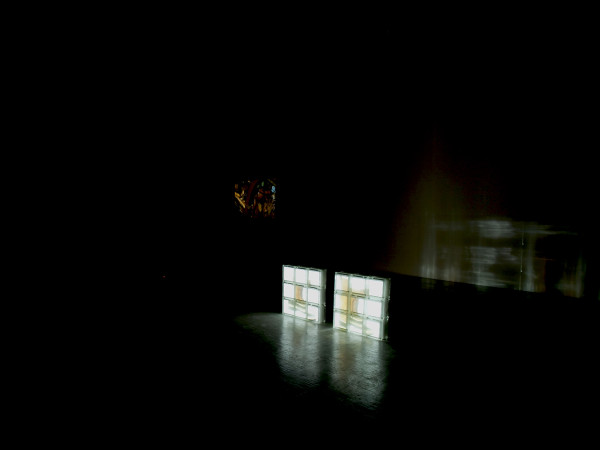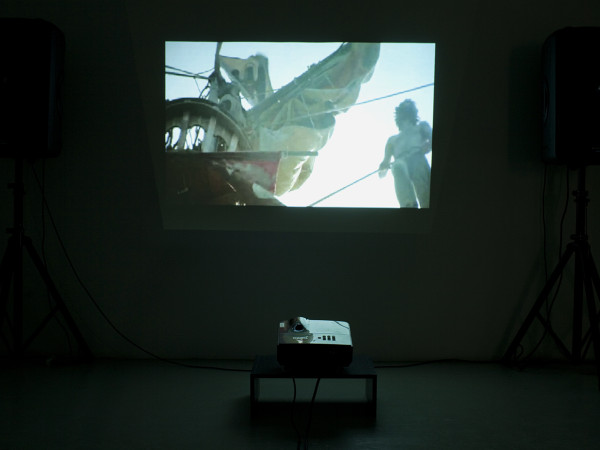The road-movie is an opportunity to travel the highways and learn about an area. Since the novels of Jack Kerouac and others, the representation of a protagonist’s inner thoughts and initiatory progression also are expressed outwardly and figuratively through the landscape bordering traffic routes. When Takao Minami appropriates this powerful form of American narrative fiction, he adds a subjective truth to the representation that of the active viewer, who, having the last word, ultimately must draw from the fiction of others, as a basically impersonal starter, thus it becomes possible to show his story.
Going from the impersonal to the personal would be the concern of Takao Minami’s recent work. Following his residency at LA CHAMBRE BLANCHE, in the winter of 2012, the Paris-based Japanese artist presented a process of accelerating and decelerating the projection of a film emblematic of this road-movie genre, Dennis Hopper’s Easy Rider, made in 1969. Using GPS digital technology, the images of the artist’s numerous journeys taken on foot, by bus and taxi during the creation period of his project were juxtaposed on the film during its projection, reproducing the speed of his recent urban movements. In other words, the superposition of the artist’s travels gradually takes over the film contents. Doing this, he also reroutes the methods of accelerating and decelerating, using the simple base function of a DVD player and he has done the same with the GPS, the usefulness of which now serves the new purpose of representing personal, private journeys.
The matter of a journey connotes the artist’s residency, in which the creative space consists of his involvement with the place to which he is adapting, by controlling the specificities and understanding its signs. In this sense, it is logical that Minami, like composers, also has only the music itself as a subject, because the rhythm of the journey is where he situates his main contribution. The appropriation of a space, taking the place of signature is a problem, it takes the artist back to his intrinsic confinement and it is true that there is a form of humour in the implicit critique of this other film that Takao Minami reread: an historical road-movie this time in which the subject heralds all the road-movies of cinema on the North American continent, that is to say Christopher Columbus’ discovery of America. In its reworked version and always involving the combination of altered speed and rhythm, Ridley Scott’s bombastic representation for the 500th anniversary commemorations of this fantastic expedition shows the derisory aspect of the appropriation process. The artist, by denying the pretence of his stratagem develops a form of liberating commentary, allowing him to negotiate with tactfully tinged irony the issues and objectives that he set himself for his residency.
But again, Takao Minami makes an effort to develop a narrative about the self under the influence of advanced media platforms. One knows to what extent the cinema can affirm the expression of the road for itself, in the cinema that was concerned with going back to the road-movie genre around the years 2000 (David Lynch, Vincent Gallo). Identity blurring is recognized here, the representation of the self surreptitiously interferes in the representation of the road, until it merges the state of the mind and mood of the viewer and the artist. This confusion of points of view gives us the opportunity to check what is hidden behind the logic of linking images in movement, in which the road-movie would be one of the purest expressions.
Why would the projection of the road concern us in any way? What has it to do with US? The abstraction of movement, for a connection to the self, shows how much Takao Minami’s work takes note of the specificities of the digital era. David Lynch has demonstrated already in his Inland Empire how much this interrelation between the viewer and individuality was also a concern of the interface, that is to say the context of actual digital expression. This being so, it is now possible to be inside and outside at the same time.
In other words, a psychic leap is put in place with the representation in art since the web, concerning a sublime non-association between the so-called “passivity” associated with the viewer who at any moment becomes “reactive.” Questioning traditional forms of expression in that way, the passing of time is no longer inevitable and bound to happen but gives the opportunity of a takeover in which the world of representations (even the most famous, the most worshipped) is only the other side of the same image of the self.


